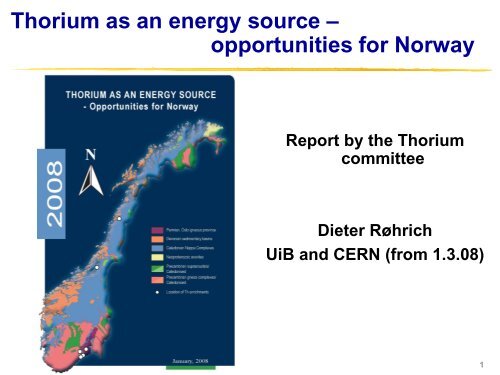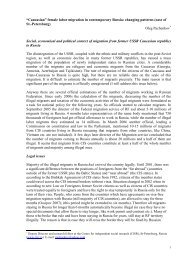Thorium and Norway
Thorium and Norway
Thorium and Norway
You also want an ePaper? Increase the reach of your titles
YUMPU automatically turns print PDFs into web optimized ePapers that Google loves.
<strong>Thorium</strong> as an energy source –<br />
opportunities for <strong>Norway</strong><br />
Report by the <strong>Thorium</strong><br />
committee<br />
Dieter Røhrich<br />
UiB <strong>and</strong> CERN (from 1.3.08)<br />
1
<strong>Thorium</strong> as an energy source –<br />
opportunities for <strong>Norway</strong><br />
The m<strong>and</strong>ate:<br />
“The Committee’s work <strong>and</strong><br />
the resulting Report shall<br />
establish a solid knowledge<br />
base concerning both<br />
opportunities <strong>and</strong> risks<br />
related to the use of thorium<br />
for long-term energy<br />
production. The work should<br />
be conducted as a study of<br />
the opportunities <strong>and</strong><br />
possibilities (screening),<br />
based on a review of<br />
<strong>Norway</strong>’s thorium resources<br />
<strong>and</strong> the status of key<br />
technologies.[...]”<br />
Concluding remarks:<br />
• The current knowledge of<br />
thorium based energy<br />
generation <strong>and</strong> the geology is<br />
not solid enough to provide a<br />
final assesment regarding the<br />
potential value for <strong>Norway</strong> of a<br />
thorium based system for a long<br />
term energy production.<br />
• The Committee recommends<br />
that the thorium option be kept<br />
open in so far it represents an<br />
interesting complement to the<br />
uranium option to strengthen<br />
the sustainability of nuclear<br />
energy<br />
2
Primary energy consumption<br />
• World energy flows at the end of the last century<br />
53% 37% 26% 8% 5% 22%<br />
oil coal gas<br />
Transportation 24% Industry 38%<br />
hydro nuclear other<br />
electricity<br />
generation<br />
12%<br />
Residential <strong>and</strong><br />
commercial 38%<br />
= 150%<br />
= 100%<br />
3
Global energy consumption<br />
4
Energy situation in Europe<br />
• Status 2004<br />
– 152 nuclear reactors -> 31% of electricity consumption<br />
– Nordic countries<br />
» Sweden: 10 units<br />
» Finl<strong>and</strong>: 4 units, one nuclear power plant under construction<br />
• The EU Climate <strong>and</strong> Energy Package - Targets by 2020<br />
– Reduction of greenhouse gas emissions by 20% compared to 1990<br />
level<br />
– Reduction of energy consumption by 20% compared to 1990 level<br />
– Increase the share of renewable sources in the EU energy mix to 20%<br />
– Increase the share of biofuels of transport petrol <strong>and</strong> diesel to 10%<br />
5
Million Tonnes Natural Uranium<br />
Cumulative natural uranium dem<strong>and</strong> <strong>and</strong> reserves<br />
6<br />
5<br />
4<br />
3<br />
2<br />
1<br />
Cumulative Natural Uranium Dem<strong>and</strong> <strong>and</strong> Reserve Levels<br />
0<br />
0<br />
2000 2010 2020 2030 2040 2050<br />
Reserves (US$80/kgU) Reserves (US$130/kgU) Nat. U dem<strong>and</strong> (Million t U)<br />
200<br />
180<br />
160<br />
140<br />
120<br />
100<br />
80<br />
60<br />
40<br />
20<br />
GtCO 2 Equivalent<br />
Nuclear Energy<br />
Agency’s Reference<br />
Scenario<br />
• Continued nuclear<br />
growth<br />
• Reported uranium<br />
reserves last until<br />
about 2040<br />
• Reported reserves<br />
depend on dem<strong>and</strong> –<br />
might increase<br />
• Breeder reactor<br />
technology would<br />
change this<br />
development<br />
6
Energy situation in <strong>Norway</strong><br />
• 100% hydro power<br />
• Production<br />
matches the<br />
consumption<br />
• Large fluctuations<br />
in production due<br />
to weather<br />
variations<br />
• Import/export via<br />
power cables to<br />
Sweden, Finl<strong>and</strong>,<br />
Netherl<strong>and</strong>s<br />
7
<strong>Thorium</strong> as nuclear fuel<br />
• <strong>Thorium</strong> has been used as nuclear fuel since the 1960s<br />
• Preparation of thorium fuel is more complex <strong>and</strong> expensive than<br />
that of uranium fuel<br />
• <strong>Thorium</strong> as a nuclear fuel is technically well established <strong>and</strong><br />
behaves remarkably well in various reactors<br />
• Reprocessing thorium fuel is complicated <strong>and</strong> will require a<br />
substantial effort for the development of a commercial plant<br />
• Waste management will in principal follow known procedures <strong>and</strong><br />
methods<br />
• Radiation protection requirements for the thorium cycle might be<br />
lower than those of the uranium cycle<br />
• Technically, one of the best ways to dispose of a plutonium stock<br />
pile is to burn it in a thorium-plutonium MOX fuel<br />
9
=<br />
Nuclear reactors for thorium fuel<br />
• U-233 has some very attractive properties as fissile material<br />
– U-233 emits so many neutrons per fission that they can sustain a chain<br />
reaction AND breed new U-233 from Th-232<br />
number of neutrons<br />
produced<br />
per neutron captured<br />
10
Nuclear reactors for thorium fuel<br />
• Advantage<br />
– Practically NO production of longlived transuranic elements<br />
-> reduced radiotoxicity of waste<br />
• Disadvantage<br />
– Smaller percentage of delayed neutrons<br />
-> more difficult to control in extreme situations<br />
– Management of parasitic Pa-233<br />
-> difficult reactor operation (online re-fuelling, special seed-blanket<br />
geometry)<br />
11
(Industrial) experience with thorium in nuclear<br />
reactors<br />
Country Name Type Power Operation<br />
Germany AVR HTGR 15 MW e 1967 - 1988<br />
Germany THTR HTGR 300 MW e 1985 - 1989<br />
UK, OECD-EURATOM<br />
also <strong>Norway</strong>, Sweden &<br />
Switzerl<strong>and</strong><br />
Dragon HTGR 20 MW th 1966 -1973<br />
USA Fort St Vrain HTGR 330 MW e 1976 – 1989<br />
USA, ORNL MSRE MSBR 7.5 MW th 1964 – 1969<br />
USA<br />
India<br />
Shippingport &<br />
Indian Point<br />
KAMINI,<br />
CIRUS &<br />
DHRUVA<br />
LWBR<br />
PWR<br />
MTR<br />
100 MW e<br />
285 MW e<br />
30 kW th<br />
40 MW th<br />
100 MW th<br />
1977 – 1982<br />
1962 – 1980<br />
In operation<br />
12
Shippingport light water reactor<br />
Pennsylvania, USA<br />
• Light water<br />
breeding<br />
reactor<br />
– Fuelled with<br />
U-233 <strong>and</strong><br />
Th-232<br />
– Produced<br />
1.4% more<br />
fuel than it<br />
burned<br />
13
Status of thorium projects today<br />
• Most projects using thorium were terminated by<br />
the end of the 1980s<br />
• Main Reasons<br />
– The thorium fuel cycle could not compete economically<br />
with the well-known uranium cycle<br />
– Lack of political support for the development of nuclear<br />
technology after the Chernobyl accident<br />
– Increased worldwide concern regarding the<br />
proliferation risk associated with reprocessing of spent<br />
fuel<br />
• Except for India<br />
– long term energy plan which includes a complicated<br />
scheme of plutonium <strong>and</strong> thorium fuel<br />
16
Future nuclear energy systems using thorium<br />
• Goal<br />
– self-sustaining thorium fuel cycle (no U-235, U-238 or plutonium)<br />
• Two potential reactor types (conceptual level)<br />
– Molten salt reactor<br />
» One of the reactor types of the roadmap of the Generation IV<br />
International Forum<br />
» Not specially designed for thorium<br />
» 20-30 years of R&D<br />
– Accelerator Driven System (ADS)<br />
» Proton accelerator + spallation target + subcritical reactor core<br />
» Very versatile <strong>and</strong> flexible concept<br />
» Part of the EURATOM FP6 roadmap<br />
(MYRRHA project in Belgium)<br />
» Considered at the moment for the<br />
transmutation of waste<br />
(<strong>and</strong> not for energy production)<br />
» 20-30 years of R&D<br />
17
<strong>Thorium</strong> market<br />
• There is no market for<br />
thorium as of today<br />
• By-product of rare<br />
earth element mining<br />
• Total amount of<br />
thorium produced<br />
worldwide:<br />
37 500 tonnes<br />
(US, Australia,<br />
China, India)<br />
22
Tonnes<br />
<strong>Thorium</strong> in <strong>Norway</strong><br />
World <strong>Thorium</strong> Reserves <strong>and</strong> Reserve Base (Resources)<br />
700 000<br />
600 000<br />
500 000<br />
400 000<br />
300 000<br />
200 000<br />
100 000<br />
0<br />
Australia<br />
India<br />
United<br />
States<br />
<strong>Norway</strong><br />
Canada<br />
Other<br />
countries<br />
South<br />
Africa<br />
Brazil<br />
Malaysia<br />
Reserve Base<br />
Reserves<br />
US Geological Survey claims that:<br />
• <strong>Norway</strong> has one of the major thorium<br />
reserves in the world.<br />
The Geological Survey of <strong>Norway</strong>:<br />
• <strong>Thorium</strong> has never been specifically<br />
explored for<br />
• Fen Complex most promising<br />
• Low concentration 0.1 – 0.4 wt%<br />
• Volume estimates are uncertain<br />
• Grain size too small for the traditional<br />
flotation processes<br />
• <strong>Norway</strong> has a potential resource<br />
• More investigations necessary to<br />
define as a reserve<br />
23
Conclusions <strong>and</strong> recommendations (1)<br />
The potential contribution of nuclear energy to a<br />
sustainable energy future should be recognized.<br />
• Volume estimates of Norwegian thorium resources are<br />
uncertain; the grain size is too small for traditional<br />
extraction processes.<br />
It is essential to assess whether thorium in Norwegian<br />
rocks can be defined as an economical asset for the<br />
benefit of future generations.<br />
• The development of an ADS using thorium is not within the<br />
capability of a <strong>Norway</strong> working alone.<br />
Joining the European effort in that field should be<br />
considered.<br />
24
Conclusions <strong>and</strong> recommendations (2)<br />
<strong>Norway</strong> should strengthen its international collaboration<br />
by joining the EURATOM fission programme <strong>and</strong> GIF<br />
programme on Generation IV reactors suitable for the use<br />
of thorium<br />
• The proliferation resistance of uranium-233 depends on<br />
the reactor <strong>and</strong> reprocessing technologies.<br />
Due to the lack of experience with industrial-scale thorium<br />
fuel cycle facilities, similar safeguard measures as for<br />
plutonium are considered m<strong>and</strong>atory until otherwise<br />
documented.<br />
25
Conclusions <strong>and</strong> recommendations (3)<br />
• Any new nuclear activity in <strong>Norway</strong>, e.g. thorium fuel<br />
cycles, would need strong international pooling of human<br />
resources, <strong>and</strong> in the case of thorium strong long-term<br />
commitment.<br />
In order to meet the challenge related to the new nuclear<br />
era in Europe, <strong>Norway</strong> should secure its competence<br />
within nuclear sciences <strong>and</strong> nuclear engineering fields.<br />
26
















